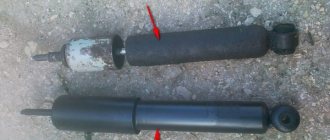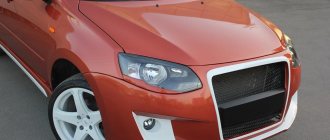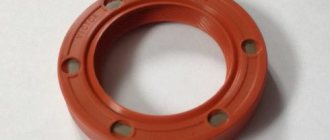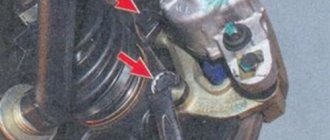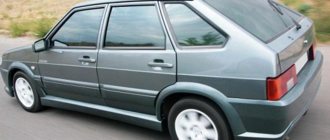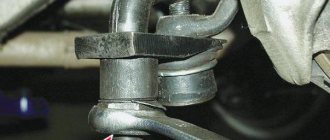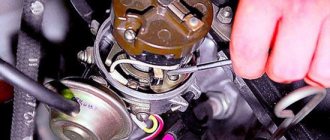Changing shock absorbers on a VAZ 2107
A car shock absorber is a device that provides not only comfort, but also safety for the driver and passengers. Shock absorbers ensure that the car's wheels are firmly pressed against the road surface, resulting in body vibrations being reduced to a minimum. The domestic car VAZ 2107 is equipped with shock absorbers, which are installed in the chassis structure near each of the wheels. Let's look at what it means to replace shock absorbers on a VAZ 2107 in detail.
Rear suspension repair
This part of the work is carried out from the inspection hole; the design provides normal access to the components of the VAZ 2107. It is better to dismantle the shock absorbers after cleaning the fasteners from dirt and rust. Unscrew the bolted connections at the top and bottom. We remove the parts and put it aside.
We install new VAZ 2107 gas damping elements in their place, which provide excellent performance. As can be seen from the description of this type of work, it is relatively simple; preparatory activities take more time.
When is it necessary to replace shock absorbers?
Both front and rear shock absorbers on the VAZ 2107 perform the same function. Despite this, these elements differ structurally. The main difference between these elements is the method of fastening, but we will learn more about this when we consider the process of replacing units.
The products in question need replacement in the following cases:
- When the mechanism becomes unusable, that is, it does not have the ability to cushion the car body and smooth out shocks. It is not difficult to detect a malfunction of this mechanism, because in this case it becomes not entirely comfortable in the car interior.
- Presence of oil leaks on the device. You can detect leaks even without removing the product from the car.
If you are convinced that the products in question need replacement, then it’s time to get down to business.
Replacing front shock absorbers on a VAZ 2107
First, let's look at what the process of replacing the front shock absorbers of a VAZ 2107 is. It is important to note that even if only one element has become unusable, it is recommended to replace them in pairs, or even better as a set. The replacement procedure is represented by the following steps:
- We recommend placing the car on a pit or overpass and then applying the brakes to the wheels. If there is access from below, then there is no need to use a jack. Otherwise, you will have to use a jack and wheel stands, which will be more labor-intensive.
- Work begins on removal from the engine compartment, that is, there is no need to jack up the front part yet, as this will complicate access to the upper nut of the product. To do this, you need to open the hood and find the product stem. There is a nut screwed onto it, to unscrew it you need to jam the rod itself with a special key. In the photo below, this wrench is indicated by the number “1”, and the number “2” is a regular wrench at “17”.
- After unscrewing and removing the nut, you need to remove the washer with the rubber cushion.
- Now you can jack up the front of the car, then remove the wheel and install the spacer. Otherwise, we go down into the inspection hole.
- We find two nuts securing the front device. This mount looks like this, shown below. Using a “13” wrench you will need to unscrew both nuts. This must be done carefully, since there are spring washers underneath. We recommend spraying them with WD-40 first, as they usually do not unscrew easily, and there is a chance of stripping the studs, which will require restoration work.
- After unscrewing both nuts, the unit can be dismantled. To do this, pull its bottom bracket, after which it will fall out.
- Using two “17” keys, you need to unscrew the nut that secures the bottom bracket of the device. This bracket must be screwed to the new product in the same way if it does not have it.
- Now you can begin installing the new element. Before installing the front shock absorbers, you must first extend the rod all the way.
- Initially, the device is fixed at the lowest point by attaching two nuts. After this, the cushion and washer are put on the rod, and then the nut is screwed in. If the car is on a jack, you will not be able to tighten the nut. To do this, you need to lower the car or load the suspension. After this, you can screw the nut all the way.
- At the bottom, you must finally secure the device with two nuts.
At this stage, the front shock absorbers can be considered replaced, then we move on to the rear of the VAZ-2107.
Replacing rear shock absorbers on a VAZ 2107
The rear shock absorbers on the VAZ 2107 have a different mounting scheme, so let’s consider their replacement principle. As you know, the rear shock absorbers on the VAZ-2107 differ from the front ones in the design of the brackets. We will find out further how to replace the rear shock absorbers of a VAZ 2107.
- The car continues to stand on the overpass or pit, which will greatly facilitate the work, since there is no need to use a jack. If there is no hole, you will have to install a jack and jack up the rear of the car. This will make the whole replacement process a little more complicated.
- Work on dismantling the part must begin with the lower bracket. To do this, you will need two “19” keys, with which you unscrew the nut securing the device. The photo below shows what this bracket is.
- After unscrewing the nut, you need to pull the bolt out a little and remove the spacer sleeve from it.
- After removing the spacer sleeve, you can remove the bolt and dismantle the spacer sleeve, and after it, release the lower part of the part.
- Now you can begin to unscrew the top mount of the device. To do this, you will need to unscrew the nut, remove the washer and rubber bushing. If the bushing cannot be removed, then it does not matter; you can continue dismantling further.
- To remove the device, you need to pull the product by hand, and then remove its upper hinge from the stud along with the bushing.
- Having picked up the product that has been dismantled, you need to remove the spacer sleeve from it, shown in the photo below.
- When replacing a shock absorber, both loops must be equipped with new rubber bands and spacers must be installed in them.
- Next, you need to fix the new part at the top and then at the bottom. Everything is done in the reverse order of removal.
How to find out about malfunctions of the front shock absorbers of Lanos struts
Lanos 1.5, which was produced by various plants of Daewoo, ZAZ and Chevrolet, is equipped with strut shock absorbers, which fail over the course of the vehicle’s operation. To find out that the machine needs to replace the devices in question, you will need to pay attention to the corresponding signs. To do this, it is not at all necessary to remove the part from the car to ensure that it is faulty.
This is interesting!
Shock absorbers and struts are considered by many to be the same devices, but they have big differences, so it is worth distinguishing between them (link).
The difference between them is that shock absorbers are integral elements of the struts. To determine the malfunction of the damping devices of a Chevrolet or Daewoo Lanos 1.5, it is necessary to resort to the following manipulations:
- Pay attention to the presence of “floating” of the car on the road at a speed of 70-80 km/h. Often, it will be difficult for a beginner to determine the malfunction of shock absorbers in this way, so it is important to take into account other factors
- When overcoming bumps, a dull sound occurs
- The presence of oil leaks on the device body is the main sign of a rack malfunction
- If under the plastic plug under the hood you can see deformed rubber in the glass, which is a bumper or seal between the bearing and the shock absorber
- If you suspect that the shock absorbers on the Lanos are faulty, then you will need to assess their condition by rocking the car. To do this, press down on the front corners of the car body and release sharply. Devices are considered to be in working order when the body rises smoothly from the bottom to the top.
- If, when rocking, the body has difficulty returning back and continues to fall again automatically, then the shock absorbers should be replaced
After the check, you will need to carry out additional diagnostics of the devices, but only when they are removed from the Lanos car. On Lanos, shock absorbers are installed at the rear and front, so it is necessary to consider the features of replacing devices separately.
This is interesting!
Shock absorbers come in different types, and when they fail, they must be repaired or replaced. Often, owners choose the second option - replacement, since their repair requires specialized equipment and is quite expensive. In addition, repairs take time, so it is much easier to buy new shock absorbers for a Chevrolet or Daewoo Lanos and replace them yourself.
Replacing front shock absorbers on VAZ 2101-VAZ 2107
Welcome! Car shock absorbers - how the car will behave in the future on smooth and uneven roads depends only on them. Over time, car shock absorbers deteriorate and therefore need to be replaced. In this article, we have written detailed instructions on how you can replace the front shock absorbers on cars of the “Classic” family.
Note! To perform the replacement, you will need the following tools: First, be sure to stock up on a set of basic wrenches and new shock absorbers. And also, if you have one, take with you a special key for removing shock absorbers; for clarity, it is shown in the figure below:
Question? Which shock absorbers do you prefer: “Gas-oil” shock absorbers or conventional “Hydraulic” ones? (Write your answer in the comments)
Summary:
When do you need to change front shock absorbers? They must be replaced if:
- Loss of its properties, that is, loss of efficiency in damping vibrations.
- And it must also be replaced with a new one if it starts to leak and as a result becomes oily.
Note! To properly verify whether the shock absorbers are working or not, you can read the article entitled: “Checking shock absorbers for performance”!
What tools are needed for replacement and where are the shock absorbers on Lanos?
Before carrying out work to replace shock absorbers on Lanos, you need to make sure you have the appropriate tools and materials. To carry out work on replacing strut shock absorbers, you will need the following tools:
- Jack - for lifting the car and removing the wheel
- Box, open-end and socket wrenches with ratchet
- Screwdriver
- Metal brush for removing dirt and corrosion from threaded connections
- Hammer with pliers
- Spring ties
- Pipe wrench
- Puller for removing the steering tip. Instead of a puller, you can use a long crowbar
- Safety stands under the car after jacking up
- A can of WD-40 lubricant to facilitate the work of unscrewing fasteners
New devices will also be needed, and it is recommended to change them in pairs, that is, the front two together and the rear ones in the same way. Even if one front or rear shock absorber fails, only both need to be replaced.
On Lanos, the mechanisms in question are located near the wheels, so finding them will not be difficult. To see the front shock absorbers, you need to remove the wheel and open the hood. When all the necessary tools and parts are ready, you can begin the immediate procedure for dismantling the replacement devices on Lanos.
How to replace front shock absorbers on a VAZ 2101-VAZ 2107?
Note! Both shock absorbers are replaced in the same way, so we will show their replacement only using the example of one shock absorber!
Removal: 1) First drive the car into the inspection hole, or hang it up using a lift.
2) Now open the hood and pick up the special key (If you don’t have it, then use small pliers). Next, place a special wrench on the shock absorber rod, which is indicated by the number “1” in the photo, thereby reducing the likelihood of the rod turning along the axis.
Immediately after this, use a wrench labeled “2” to unscrew and then remove the nut, after the nut, remove the spring washer, as well as the cushion washer and the upper shock absorber mounting cushion itself.
Note! If you are working on a lift, then perform this operation with the car standing on the ground!
3) Then crawl under the car, and there, unscrew the two nuts that secure the bracket to the lever.
Note! Unscrew the nuts carefully, because above them there are spring washers that will also need to be carefully removed. If both lower nuts are soured, then apply WD-40 grease to them, thereby ensuring they can be easily loosened!
4) When both nuts that secure the bracket to the lever are unscrewed, pull down the shock absorber and therefore remove it from the car.
5) When the shock absorber is removed, remove the lower cushion from its rod.
6) Next, holding the bolt from turning with one wrench, with the other, unscrew the nut that secures the bracket to the shock absorber and then remove the bolt, thereby removing the small washer and the bracket itself.
Note! You can install the removed bracket on a new shock absorber if it is missing!
Installation: Installation of a new car front shock absorber is carried out in the reverse order of removal.
Note! Before installing a new shock absorber, pull out the rod all the way. After which, for convenience, you can first put a washer on the rod, then a cushion, and then screw the nut on top!
If you do all the work on a lift, then lower the car to such a state that it touches the ground, in other words, so that its suspension is loaded under the weight of the car itself!
If the shock absorber rod comes out from above but not all the way, then first put the cushion washer on it and then screw the nut on top. When the nut is screwed on, using a lever principle, use a screwdriver or wrench to pull the rod up to the top until it stops!
Additional video clip: To make it easier for you to understand the procedure for replacing shock absorbers, then watch a video clip prepared especially for you just below, in which everything is described and explained in detail.
Source
Disassembly and assembly of shock absorber VAZ 2107, VAZ 2105, VAZ 2104, Lada Zhiguli, Classic
NOTE To secure the shock absorber and its parts in a vice, use special jaws 67.7824.9513-001.
Shock absorbers of the front and rear suspensions of the VAZ 2104, VAZ 2105, VAZ 2107: 1 - lower eye; 2 — compression valve body; 3 — compression valve discs; 4 — throttle disk of the compression valve; 5 — compression valve spring; 6 — compression valve cage; 7 — compression valve plate; 8 — recoil valve nut; 9 — recoil valve spring; 10 — shock absorber piston; 11 — recoil valve plate; 12 — recoil valve discs; 13 — piston ring; 14 — recoil valve nut washer; 15 — throttle disk of the recoil valve; 16 — bypass valve plate; 17 — bypass valve spring; 18 — restrictive plate; 19 - reservoir; 20 - rod; 21 - cylinder; 22 — casing; 23 — rod guide bushing; 24 — sealing ring of the tank; 25 — rod seal race; 26 — rod seal; 27 — gasket of the rod protective ring; 28 — rod protective ring; 29 — tank nut; 30 — upper shock absorber eye; 31 — nut securing the upper end of the front suspension shock absorber; 32 — spring washer; 33 — shock absorber mounting pad washer; 34 — pillows; 35 — spacer sleeve; 36 — front suspension shock absorber casing; 37 — rod buffer; 38 - rubber-metal hinge
Unscrew the nut 29 of the reservoir with the key A.57034/R, remove the working cylinder 21 with the rod 20 and its parts from the reservoir. Release the reservoir from the vice and drain the liquid from it. Using wrench 67.7824.9513–005, remove rod guide sleeve 23 from the working cylinder. Remove piston 10 with rod from the cylinder and drain the liquid. Carefully, using a special mandrel, knock out the 2 compression valve housing assembly from the cylinder. Place the rod with the piston into the jaws, clamp it in a vice and unscrew nut 8 of the recoil valve. Remove piston 10 with valves (bypass and return), guide sleeve 23, rod seal 26, seal race 25 and other parts.
NOTE For the front suspension shock absorber of VAZ 2104, VAZ 2105, VAZ 2107, for ease of inspection of the rod surface covered by the casing, it is also recommended to compress the casing.
Disassemble the compression valve by removing the holder 6, and then sequentially remove the spring 5, plate 7 and valve discs 3 and 4 from the body 2.
Shock absorber malfunctions
Any car malfunction always manifests itself in the form of extraneous noise, unusual behavior of the vehicle or other signs. Problems with shock absorbers also have certain symptoms, and if they are detected, you should not delay replacing the dampers.
Oil leakage
The most common sign that a shock absorber has become unusable is a fluid leak. Leaks on the body indicate a loss of seal in the oil reservoir. As a result, not only leaks occur, but also air leaks. In this case, the damper rod has free movement, i.e. it moves without any effort, and the part loses its functionality. If signs of smudges have just appeared on the shock absorber, it will serve a little longer, but you should not leave it without attention and it is better to replace it in the near future.
Body rocking
Since springs and shock absorbers work together to dampen vibrations that occur when driving over bumps, contact with the road may be lost if the damper fails. In this case, shaking increases, the body sways, and the level of comfort decreases. The car becomes rolly, and when it hits obstacles it sways for some time. The easiest way to check the shock absorbers of your “seven” is to press the wing, try to rock the body, and then release it. If the car continues to swing on the springs for some time, then this is a clear sign of a faulty damper.
Body roll
One symptom that indicates problems with the suspension shock absorbers is body roll when cornering. This behavior of the car negatively affects safety, since the quality of braking, as well as vehicle control, suffers. If liquid has leaked from the damper, it will be quite difficult to keep the car turning, which is especially dangerous in winter. When the mileage of the products in question is more than 60 thousand km, which also depends on the quality of the parts themselves and the operating conditions of the vehicle, handling may noticeably deteriorate. But since the process does not occur at one moment, but gradually, the driver practically does not notice this and rolls can be perceived as a normal phenomenon.
Suspension noise
Extraneous sounds in the suspension, uncharacteristic of its operation, indicate the need to check and service this mechanism. When dampers and their bushings wear out, the ability to effectively support the weight of the machine is lost. In addition, so-called shock absorber breakdowns often occur.
Suspension breakdowns are metal elements touching each other, which leads to a knocking sound.
Uneven or increased tire wear
If it has been noticed that the tire tread has uneven wear or wears off too quickly, then this is a clear sign of problems with the suspension. With faulty shock absorbers, the wheel moves vertically with a much greater amplitude, which leads to uneven tire wear. When driving, extraneous noise appears on such wheels.
Plunging when braking
Among car owners there is such a thing as “the car bites.” If the dampers fail, the front of the car will dive during braking, and the rear will sag when accelerating. This is explained by the fact that parts that have become unusable do not cope with their function, that is, they do not support the weight of the machine.
Checking the serviceability of shock absorbers
But before we describe the work process, we will consider ways to identify a shock absorber malfunction.
The first sign, as already indicated, is a knocking sound on one or both sides of the car when passing strong bumps.
A visual inspection will also help to identify the malfunction. Oil leaks can often be seen on the outside of the damaged element.
This indicates that the shock absorber has lost its seal and some of the oil is leaking out.
You can also assess the condition by rocking the body. To do this, you need to go to one of the front wheels and with both hands press firmly on the body to overcome the resistance of the springs.
You need to press several times to set the amplitude of oscillations as large as possible, and then suddenly stop swinging.
If the shock absorber is working properly, the body will immediately return to its original position, without any vibrations.
If there are vibrations, even minor ones, the shock absorber is faulty.
It is necessary to check by rocking on both sides of the car, since replacement must be done at least in pairs - two shock absorbers of the front suspension or rear suspension are changed at once. It's even better to change all the elements at once.
We will not consider replacing the rear shock absorbers for now; everything stated below will concern only the front suspension.
Replacing the front shock absorber on the “seven”
When damaged, front suspension dampers are usually replaced with new ones. Sometimes owners try to repair them on their own, which requires some experience, the purchase of a repair kit and special oil, but only dismountable shock absorbers are suitable for such a procedure. Before you start replacing, you need to decide which elements to install on your car.
Selection of shock absorbers
The question of choosing dampers for the “seven” is quite difficult for many, which is due to the wide variety of such products. The following types of shock absorbers can be installed on the “classic”:
- oil;
- gas-oil with constant hardness;
- gas-oil with variable hardness.
Each type is characterized by its pros and cons and is produced by different manufacturers. It is necessary to select a product based on the operating conditions of the vehicle and the driving style of the owner.
Oily
Although the “seven” is basically equipped with oil shock absorbers filled with hydraulic fluid, many are not satisfied with their performance. The main disadvantage of such dampers is their slow response. If the car moves at high speed, the shock absorber does not have time to return to working condition, which leads to swaying on the springs. Therefore, they are recommended for those owners who do not operate their cars at speeds exceeding 90 km/h.
Gas-oil
Gas-oil shock absorbers use oil and gas, which increases the operating efficiency of the product and improves handling of irregularities. The main working medium is oil, and gas stabilizes operation by removing excess foam and increasing the efficiency of response to changes in road conditions. Equipping Zhiguli cars with such dampers has a positive effect on driving performance. There is virtually no sway at relatively low speeds. Among the minuses, it is worth highlighting omissions during sharp impacts.
Gas-oil with variable hardness
On the “Seven”, as well as on other “classics”, such elements are practically not installed, which is due to the high price. Products of this type are equipped with a special valve with an electromagnet. By means of the valve, it is adjusted to the operating mode of the vehicle and the amount of gas in the main cylinder of the damper is adjusted with a change in the rigidity of the device.
Video: types of shock absorbers and their differences
Manufacturers
During repairs, many owners install standard elements. Those who want to improve the performance of the suspension purchase gas-oil components. However, you have to choose from foreign manufacturers, since domestic ones do not produce such products. The most popular brands include:
Table: analogues of front dampers for VAZ “classics”
| Manufacturer | vendor code | price, rub. |
| KYB | 443122 (oil) | 700 |
| KYB | 343097 (gas) | 1300 |
| Fenox | A11001C3 | 700 |
| SS20 | SS20177 | 1500 |
| Sachs | 170577 (oil) | 1500 |
How to remove
To dismantle a faulty shock absorber we will need:
The event consists of the following actions:
- We hang the front of the car using a jack.
- Open the hood, unscrew the upper shock absorber mount in the mudguard hole using a 17 key, holding the rod with a 6 key.
Video: replacing front end dampers on classic Zhiguli cars
How to prepare for installation
The process of installing shock absorbers on a VAZ 2107 does not cause any difficulties. However, for proper and long-term operation they need to be prepared - pumped. Since the procedure differs depending on the type of device, we will dwell in more detail on the preparation of each of them.
Bleeding oil shock absorbers
We pump oil-type dampers according to the following algorithm:
- We install the product with the stem down and gradually compress it.
- We wait a few seconds, holding the part with our hands in the same position.
Bleeding gas shock absorbers
The procedure for dealing with gas dampers is as follows:
- Turn the part over with the stem down.
- Smoothly recess the rod and fix it for a few seconds.
- Turn the product over again and hold for no more than 6 seconds.
- Fully extend the stem.
- We turn the part over, pause for a couple of seconds and repeat steps 1–4 several times.
- We finish pumping at step 4.
- To check the performance of the part, perform step 7 on pumping the oil shock absorber.
Video: preparing gas-oil shock absorbers for operation
How to put
It is recommended to fully extend the rod before installing the shock absorber. If the damper was removed due to wear of the rubber pads or silent block, we replace them with new ones. Installation is carried out in the reverse order of removal.
If the front shock absorber of your "seven" fails, you do not have to contact a service center for help - the repair can be done on your own without special tools and extensive experience in carrying out procedures of this kind. To replace the damper, it is enough to familiarize yourself with the algorithm of actions and follow them during operation.
Source
How to choose shock absorbers
Choosing shock absorbers is not an easy task, since it is necessary to take into account a number of important factors that will subsequently affect the handling and service life of the car’s suspension. First of all, you need to pay attention to the following points:
- type of racks (gas or oil);
- length;
- permissible loads;
- compatibility with specific brands and models of cars.
The type of struts affects the stiffness of the suspension and its service life. Thus, gas struts are better suited for those drivers who prefer a more or less sporty ride and the most informative and “understandable” steering wheel. Installing oil-filled shock absorbers is more preferable for quiet motorists who use the car to perform everyday tasks.
Oil dampers are softer than gas dampers and provide comfort for the driver and passengers. Gas models are quite rigid, but this is a kind of payment for greater stability of the car on the road.
The length of the struts affects the vehicle's ground clearance. Installation of tuning models of struts with a lowering from -30 to -70 mm has a positive effect on the handling and stability of the car, as the center of gravity is reduced. There are models on the market with both factory length parameters and modified ones.
The permissible load indicator indicates how much the car can be loaded without compromising the condition of the suspension. As a rule, in expensive gas models this indicator is higher, which has a positive effect on the overall condition of the suspension and the service life of its parts.
